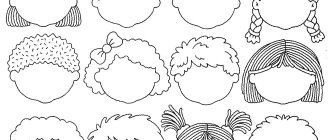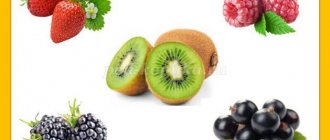Drawn pictures
Any product drawings are excellent material for:
- speech games;
- conversations;
- speech therapy exercises.
It is useful to use together both sets of subject cards with images of food and plot pictures of this topic.
Healthy and unhealthy food products are shown separately in pictures for children; it is important to teach children to easily distinguish between them.
Cards with drawn pictures are suitable for:
- classes;
- games;
- exercises.
Oil
Cheese
Dairy
Meat
Sausages
Canned food
Bread
Cereals, pasta
Cookies, bagels, crackers
Composition of puree Topic
According to the manufacturer, only natural ingredients are used in the manufacturing process:
- Rabbit meat, poultry, beef, veal, which is supplied by proven meat plants.
- Vegetables. The recipe uses easily digestible vegetables that normalize the functioning of the toddler’s stomach and intestines.
- Potato starch. In purees for children over 6 months old, starch is used to give the dish a thicker structure. Some doctors believe that a small amount of it is even beneficial for a growing organism: it massages the intestines, is a source of energy, and improves stool.
- Sunflower oil. Saturates the child’s body with vitamin E, F, fatty acids, which are necessary for the proper functioning of the liver, blood vessels, and heart.
- Cereals. Rice and buckwheat are considered the healthiest cereals for children.
- Salt. Small quantities of it are present in the recipes of dishes for children from six months of age.
- Parsley or dill extract. The puree contains beneficial vitamins A, C and ascorbic acid. This herb improves digestion and appetite in children.
Doman cards
Use Doman's cards in speech development classes on the topic Products. Bright, clear images with text can be used in games and exercises.
You can also use photos of food. It is important to choose those that have a neutral background, preferably a light one. Of course, photographs should be printed in advance and pasted onto cardboard.
How to introduce purees for children Topic
Baby puree The topic is introduced as simply as home-cooked dishes.
- Vegetables. The introduction of complementary feeding to 6-month-old babies begins with grated vegetables. The best product for introducing a new food for the first time is zucchini or pumpkin; they contain a large amount of nutrients. Start with one teaspoon of a new dish at the beginning of feeding. If an allergic reaction or intestinal dysfunction does not appear the next day, you can increase the volume of complementary foods to 150 grams.
- Fruits. Children's doctors say that until the age of one, a child does not need to eat fruit. They can cause allergic manifestations in the baby. Green apples and pears are the fruit sweets that you can offer your little one in puree first.
- Meat and meat and vegetable products. The best time to introduce meat dishes is between 6 and 8 months. During this period, the baby actively needs proteins, iron and potassium, which are contained in meat. Concern Tema makes its purees from easily digestible types of meat: rabbit, turkey, chicken. For the first time, we recommend mixing the meat with the baby’s usual cereals or breast milk.
- Before use, the puree is placed in a baby container and heated in a water bath or in the microwave to the desired temperature. There is no point in reheating leftover food.
Story pictures
Use story pictures to compose stories with children in the classroom. For these purposes, plot paintings on the themes: “Grocery supermarket”, “At the vegetable market”, “First cucumber”, “Cooking with mom”, “How the orchard feeds us in winter” are suitable.
Chapter I. PROPER ORGANIZATION OF NUTRITION IN A PRESENTER
The physical qualities of a preschool child are expressed by significant growth rates, active motor energy, skeletal and multifunctional restructuring of each organ, including the digestive organization, and the subsequent formation of the mental zone.
Current SanPiNs regulating nutrition issues in preschool educational institutions
Organization of meals for children in groups
Activities related to organizing child feeding within groups are carried out under the guidance of a teacher and also consist of:
- creating safe situations during preparation and during meals;
- formation of cultural and hygienic abilities during the child’s meal period.
Meals in groups are taken exactly according to the schedule approved by the head of the preschool educational institution. It is strictly forbidden to involve preschool children in receiving food from the catering unit. On the eve of food distribution, the nanny should:
- wash tables with warm water and soap;
- wash your hands well;
- wear a special uniform for receiving and serving food;
- ventilate the room;
- set tables according to meals.
Ensuring compliance with sanitary and hygienic requirements
Organization of children's meals. The main requirement for proper organization of nutrition for preschool children is considered to be serious compliance with sanitary and hygienic conditions in the catering unit, preparation and storage of food.
To prevent acute intestinal diseases and food poisoning, catering department employees seriously follow the established requirements for the technical processing of products and maintaining their own hygiene.
Activities held in kindergarten
- Arrival of products only with documents;
- There is a diary of perishable products that have an expiration date;
- Food products are processed: eggs, meat, cans, vegetables and fruits;
- Approved products are used for cooking;
- Products made are checked every day.
Let's consider the basic sanitary standards regulating nutrition in preschool educational institutions in Table 1.
Table: Regulatory issues on nutrition in preschool organizations
| Title of the document | What nutrition issues in preschool organizations are regulated? |
| SanPiN 2.3.2.1293-03 | On hygienic standards for the safety of products with food additives and excipients |
| SanPiN 2.3.2.1078-01 | On hygienic requirements for the safety and nutritional value of products |
| SanPiN 2.3.2.1940-05 | On sanitary requirements for baby food |
| SanPiN 2.4.1.3049-13 | On sanitary requirements for the process of storing and preparing food in a preschool organization; on taking into account the norms of physiological needs of preschool children for nutrients and energy when drawing up menus; frequency of meals for children in preschool educational institutions |
| SanPiN 2.1.4.1074-01 | On sanitary requirements for drinking water |
| Order of the Ministry of Education of the Russian Federation No. 178 of March 11, 2012 | General recommendations for organizing meals in educational organizations: frequency of meals, diet, distribution of nutritional value of food products throughout the day, etc. |
| MP 2.4.5.0107-15.2.4.5 Hygiene. Hygiene of children and adolescents. Baby food. Organization of nutrition for preschool children in organized groups. Methodological recommendations (approved by the Chief State Sanitary Doctor of the Russian Federation on November 12, 2015) | The range of products needed in children's nutrition is reflected, the recommended average daily set of products for preschoolers is indicated, a table with the distribution of nutritional value of food products during the day |
See also works:
- Working as a nanny with preschool children diagnosed with mental retardation
- The influence of family education styles on the formation of self-esteem in children of senior preschool age
- Correction and development of the social-emotional sphere in preschool children with attention deficit disorder (ADHD)
Principles of rational nutrition for children in preschool institutions
The basic principle of preschool nutrition should be the maximum variety of food rations.
The main foundations for creating a balanced diet in preschool educational institutions are:
1. The corresponding energy value of the menu, which is responsible for the child’s energy consumption.
2. Balance of food for absolutely all replaceable and essential nutritional factors, along with proteins and amino acids, dietary fats and fatty acids, various classes of carbohydrates, vitamins, mineral salts and microelements.
3. A large variety of menus, which are the main requirements for ensuring their balance, achieved through the necessary assortments of products and different culinary processing methods.
4. Correct scientific, technical and culinary processing of products and dishes ensures their high taste and preserves their original nutritional values.
5. Exclude from the nutrition menu foods and dishes that can have an irritating effect on the mucous membrane of the digestive system, and foods that worsen the health of preschool children with chronic diseases (not exacerbation) or compensated functional disorders of the gastrointestinal tract (facilitating nutrition).
6. Taking into account the characteristic qualities of preschoolers: their intolerance of certain foods and dishes.
7. The guarantee of sanitary and epidemiological safety of food includes all sanitary requirements for the conditions of the catering unit, transportation of food products, their preparation, storage, and distribution of dishes.
Daily intake of proteins, fats and carbohydrates
The need to obtain basic substances and energy in preschool children increases significantly in contrast to young children. In this case, the daily requirement for energy must be met thanks to proteins - by 12-14%, fats - by 25-35% and carbohydrates - by 55-60%.
To meet these needs, children must take the right amounts of different foods in specific proportions. With all this, the proportion should be 1:1:4 (protein, fats, carbohydrates).
The protein element of the diet is created, first of all, thanks to products that represent the main bases of proteins, this includes meat and meat products, fish and fish products, milk and dairy products, as well as eggs. The daily amount of dairy products should be 500 ml, with the advantage given to lactic acid products. Cheese and cottage cheese hold their own importance, including not only protein, but also representing the main bases of vitamin B2 (riboflavin) and calcium. The appropriate amount of meat (including offal) is 100 g daily, fish - 50 g. In feeding preschoolers, it is possible to use offal (tongue, heart, liver), rich in folic acid, vitamin B12 and vitamin A, as well as iron.
The fatty element of the menu is usually created from vegetable and butter oils, the daily amount of which is approximately 8-10 g and 25 g, according to this. Vegetable oil is needed as a resource of polyunsaturated fatty acids, which are not synthesized in any way in the body, and also come only with food. Vegetable oils also include vitamin E, a major natural antioxidant.
The main bases of carbohydrates are fruits, vegetables, pasta, cereals, glucose, bakery and confectionery products. The appropriate amount of potatoes is 150-200 g, vegetables - 250-300 g per day, in a different list (carrots, cucumbers, tomatoes, beets, pumpkin, zucchini, various vegetation). Various fruits (150-200 g) can be used - from apples to tropical fruits. In addition, juices, dried, and frozen vegetables and fruits can be used.
Cereals are used to make porridges, side dishes, soups, casseroles, puddings and other dishes. Their number should be approximately 40-45 g per day. In the feeding menu, it is possible to use peas and beans as one of the ingredients in soups; green peas are used as a side dish, as well as in salads.
The daily amount of bread is 150-170 g, 1/3 comes from the rye bread portion.
The amount of glucose should be 40-50 g, confectionery products - 20-40 g. Among delicacies, it is more correct to use honey (taking into account personal tolerance), marmalade, marshmallows, jam, marshmallows, jams.
Coloring pages
Speech therapists and teachers always use thematic coloring books to develop a child’s speech. Regular coloring not only helps children enrich their vocabulary and learn new grammatical structures, but also helps train fine motor skills, which, in turn, greatly helps activate the speech centers of the child’s brain.
Use pictures of Unhealthy Foods for children to color, this will not only improve speech skills, but also form an understanding of the basics of healthy eating and reasonable dietary restrictions. After coloring, you can have a conversation on the topic “The benefits and harms of the foods we eat.” It is easy to make a small presentation or collage from children's drawings, which can serve as additional visual material.
Assortment of baby purees Tema
Tema puree is presented in a wide range:
- Meat and vegetable . The chicken and beef that are used to prepare these purees are prepared in special farms in the south of Russia. In addition, inside the jars of Tema puree you can find fresh vegetables and cereals: rice, buckwheat, broccoli and zucchini.
- Meat . You can pamper your baby with fresh meat mixes from rabbit with chicken, beef with the addition of tongue or heart by purchasing one-ingredient baby purees from the Tema brand. The recipes for these delicacies were developed by the Scientific Research Institute of the Meat Industry.
- Fruity . Little sweet tooths will be delighted with delicious fruit mixtures of apple, pear, and plum. In some Tema fruit purees, the manufacturer uses low-fat milk yogurt or cream.
- Vegetable . Zucchini, carrot and pumpkin are ideal first complementary foods for babies aged 4-6 months.
We immediately recommend that you familiarize yourself with the best baby purees.








